



June 2014
Jupiter's Great Red Spot
The most famous storm in the solar system is getting smaller. The Great Red Spot on Jupiter has been decreasing in size over the past couple hundred years. The cause of this is still unknown.
In the 1800's it was estimated that the Great Red Spot was about 25,500 miles on its longest axis. When Voyagers 1 and 2 flew by in 1979, they measured the spot to be 14,500 miles across. Hubble measured the spot in 1995 at 13,020 miles across. By 2009 the spot had shrunk to only 11,130 miles across. Today the Great Red Spot is down to 10,250 miles across, less than half the size measured in the 1800's.
The Great Red Spot is not only shrinking in size, it is also changing shape. Over the past 20 years the spot has gone from an elliptical shape to more of a circular shape.
Current photos show small eddies around the spot which may be feeding into the storm. It is hypothesized that these eddies may be changing the dynamics of the spot.
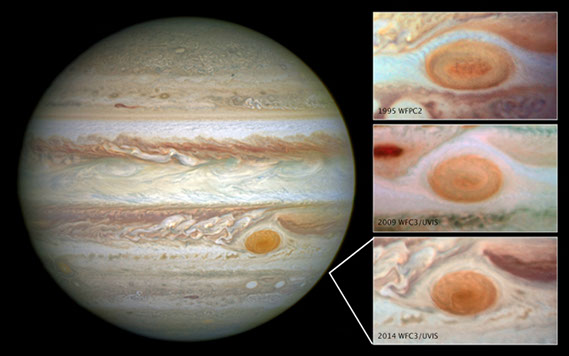
Credit: NASA/ESA
Massive Cluster Formation
NASA's Spitzer Space Telescope is studying the darkest, densest and dustiest areas of the cosmos. These are huge clouds of cosmic dust located about 16,000 light-years away. They are so dark and dense that the only way to study them is by studying their shadow.
Unable to study these areas in the visible light spectrum, Spitzer was called upon to study them in the infrared. In these clouds star formation is taking place on a massive scale. The cloud has a mass equivalent to 70,000 of our suns packed into a 50 light-year radius. The cloud will evolve into one of the most massive young clusters in our galaxy, producing powerful O-type stars.
O-type stars are blue-white stars at least 16 times the sun's mass. They burn at temperatures over 54,000 degrees F (30,000C). They have short lives that end in supernovas which form heavy elements, the type of elements needed to produce life. Scientists are not sure how or why these massive stars form, but by studying these dark dense clouds where they are forming, new theories and insight will be discovered.
Clusters of low-mass stars have been well investigated as they are quite common. But the formation of massive clusters with O-type stars has never been found until now.
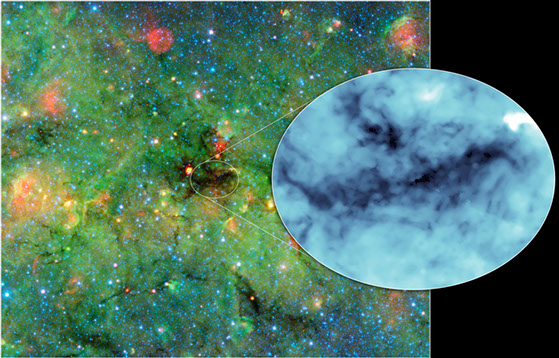
Credit: NASA/JPL-CalTech/University of Zurich
Visit our sponsors.
For advertising opportunities on this page and our videos, contact
Upcoming Launches
NO LAUNCHES SCHEDULED FOR JUNE 2014
Date: July 1
Launch Vehicle: Delta II
Launch Site: Vandenberg AFB, California
Description: Orbiting Carbon Observatory to study carbon dioxide in the atmosphere to help scientists learn more abou the impact of CO2 on climate change.
Kepler-10c
It is called Kepler-10c. It is a huge rocky planet that weighs 17 times more than the Earth and is 2.3 times larger. Up until now it was thought that a rocky planet this size could not exist.
Because of the large gravitational forces, it was thought that a planet this size would form into a large gas planet, like the huge gas planets in our solar system such as Jupiter. But this planet is rocky, like Earth.
Kepler-10c orbits a star much like our sun. But Keplar-10c is too close to its sun which make the temperatures too hot for life as we know it to exist there. The planet orbits its sun once every 45 days.
Located in the constellation Draco, 560 light-years from Earth, Keper-10c is rewriting the books on the formation of planets.
Red and Dead Galaxies
Astronomers call them "red and dead" galaxies. They are elliptical galaxies that contain very old red stars with little or no young stars being formed. Data from NASA's Chandra X-ray Observatory and ESA's Herschel Space Observatory is now unlocking clues to why this is so.
Stars are formed in cold gas. It was originally theorized that these galaxies do not contain enough cold gas to form stars. But Herschel discovered that there are abundant amounts of cold gas in some of these galaxies. In a sample of eight galaxies, six contained cold gas but no star formation. It would be expected to find star formation under these conditions.
Chandra then looked at the galaxies in the X-ray and radio wavelengths. Chandra discovered that the cold gas found by Herschel was the result of hot gas being cooled. But for some reason, the gas did not cool enough to reach temperatures for star formation. There was something that was stopping the cooling. That 'something' turned out to be Black Holes.
Energy is being produced when matter is sucked into the Black Hole, which creates outbursts that prevent the hot gas from cooling enough.
In the galaxies that contained no cold gas, the jets of energy from matter falling into the Black Holes were also present. This energy prevented the cooling of the hot gases.
In the photos, NCG 4636 and NGC 5044 are samples of galaxies with cold gas that does not cool enough to form stars. NGC 1399 and NGC 4472 are examples of galaxies that show no cold gas present.
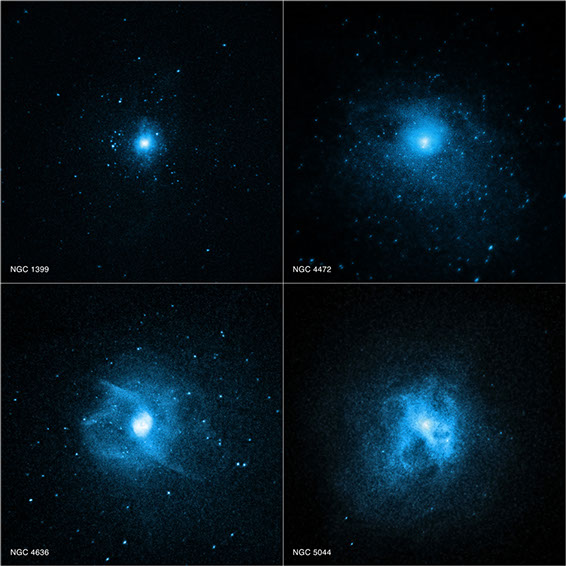
Image Credit: X-ray:NASA/CXC/Stanford Univ/N. Werner et al; Optical: DSS
Magnetars
When a massive star collapses during a supernova explosion, it either forms a neutron star or a Black Hole. One type of very rare neutron star is a Magnetar. A Magnetar is so dense that a teaspoon of it has a mass of a billion tons. Its magnetic strength is millions of times more powerful than the strongest magnets on Earth, they are the strongest magnets in the Universe. They also release vast amounts of gamma rays. But why they formed, instead of a Black Hole has been a mystery.
It has been theorized that for a Magnetar to form, there would have to be a binary star system of massive stars. But no second stars have been found in the two dozen Magnetars known. It would take a massive star to form a Magnetar. But when a massive star explodes, it forms a Black Hole. So the theory is that a second massive star needs to be present.
European scientists have been using the ESO's Very Large Telescope in Chile to study a Magnetar located 16,000 light-years away in the constellation Ara. They could not find a companion star, so they started looking for runaway stars near the Magnetar. There they found it. A single star, remains of a supernova explosion that had low mass, high luminosity and a carbon rich composition. This star could only be formed in a binary system.
In a binary system of two massive stars, when the bigger of the two starts to run out of fuel, it transfers some of its outer layers to its companion star. This causes the companion star to rotate faster and faster building up a strong magnetic field. The companion star begins to gain a lot of mass and it starts to send some of that mass back to the first star.
It is the second transfer of mass that reduces the companion star enough that when it goes supernova it does not form a Black Hole but instead a neutron star that has an ultra-high magnetic field - a Magnetar.
The first star is thrown out into space during the supernova and becomes a 'runaway' star.
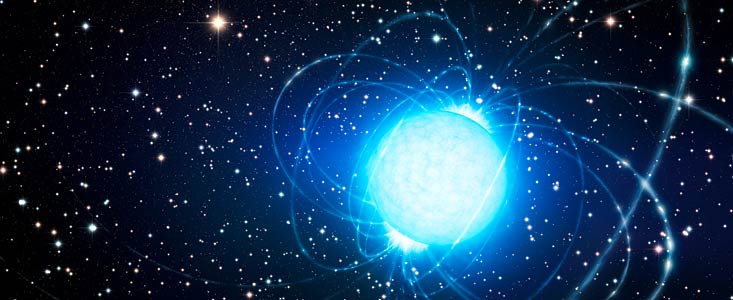
Artist's concept of a Magnetar -
Image credit: ESO
SPHERE - Exoplanet Imager
The Spectro-Polarimetric High-contrast Exoplanet REsearch (SPHERE) instrument has been installed at ESO's Very Large Telescope at the Paranal Observatory in Chile. SPHERE was developed by a consortium of European institutes working in partnership with ESO.
SPHERE is the most advanced instrument created for the study of exoplanets. It combines several techniques to give the highest contrast ever for direct planetary viewing. Special optics, detectors and coronagraphs were developed specifically for SPHERE. Special optics will help see through Earth's atmosphere. The coronagraph will block out the light of the planet's sun. Then SPHERE will be able to view the planet directly and make its studies.
This is one of the first images taken by SPHERE. It is of star HR 4796A and you can clearly see the ring of dust around the star. The coronagraph instrument had blocked out the massively bright light from the star allowing the ring to be visible.
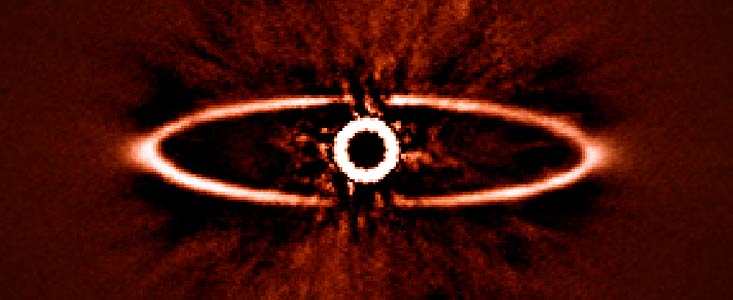
Image Credit: ESO
© 2014-2016 Ted Cook Productions LLC. - All Rights Reserved